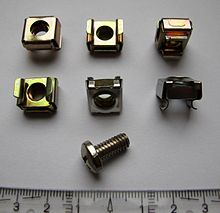Cage nut
A cage nut (or box nut) is a mostly square nut that is held in a square cage made of sheet metal. By means of the cage, the nut can be fixed to a sheet, so that even in thin sheets may be sliced, in which no thread, a nut thread can be provided. Cage nuts are standardized in DIN 557 as a special type of square nuts, as used in control cabinets .
The cage has lugs that can snap into a usually square hole in the sheet metal . The hole is slightly smaller than the cage, so that there is still a support between the sheet metal and the nut to absorb the axial thread force. The direction of force should be selected so that the nut is pressed against the sheet metal. The form fit between the nut and sheet metal via the snapping lugs is suitable for absorbing the torque when tightening and loosening the screw .
Cage nuts are mainly used for fastening devices in 19-inch racks , for example for components of servers , network distributors or laboratory devices . The front panel of the device is attached to the cage nuts of the rack frame with screws. The usual size is M6 , more rarely M5.
There was an older use for cage nuts in the automotive industry , as there are a particularly large number of assembly points on thin sheet metal in which a thread cannot be cut. Often at the end the back of the sheet is no longer accessible, so that the nut has to be placed beforehand. The increased use of welding technology has pushed back its use in this area.

